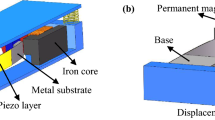Abstract
A novel hybrid energy harvester integrated with piezoelectric and electromagnetic mechanism is designed for powering wireless sensor nodes in smart grid. In the proposed energy harvester device, four permanent magnets are attached on a piezoelectric cantilever array, and a Printed circuit board (PCB) with induction coils is mounted surrounding the magnets. The magnets couple to magnetic field of Alternating current (AC) carrying conductor and excite the piezoelectric cantilever array. Vibration energy is converted to electric energy via both piezoelectric and electromagnetic transduction mechanisms. A prototype in volume of 50×50×12 mm3 was fabricated and tested. From current-carrying conductor of 2.5A at 50 Hz, the proposed energy harvester combined with piezoelectric components and electromagnetic elements can generate up to 295.3 μW and 46.6 μW, respectively. With the total output power of 341.9 μW, the power density is much higher than the one generated only by conventional piezoelectric energy harvester under the same condition.
Similar content being viewed by others
References
C. O´Mathuna, T. O’Donnell, R. V. Martinez-Catala, J. Rohan and B. O’Flynn, Energy scavenging for long-term deployable wireless sensor networks, Talanta, 75 (3) (2008) 613–623.
J. Park, S. Lee and B. M. Kwak, Design optimization of piezoelectric energy harvester subject to tip excitation, Journal of Mechanical Science and Technology, 26 (2012) 137–143.
L. Xie and R. Du, Harvest human kinetic energy to power portable electronics, Journal of Mechanical Science and Technology, 26 (7) (2012) 2005–2008.
D. Vasic, Y.-Y. Chen and F. Costa, Self-powered piezoelectric energy harvester for bicycle, Journal of Mechanical Science and Technology, 28 (7) (2014) 2501–2510.
E. S. Leland, P. K. Wright and R. M. White, A MEMS AC current sensor for residential and commercial end-use monitoring, J. Micromech. and Microeng., 19 (2009) 094018.
I. Paprotny, E. S. Leland, R. M. White and P. K. Wright, Optimization of a die-sized (10×10×4 mm3) MEMS AC energy scavenger for residential and commercial electricity end-use monitoring, Power MEMS 2009, Washington DC, USA, December 1-4 (2009).
B. Yang, C. Lee, W. Xiang, J. Xie, J. H. He, R. K. Kotlanka, S. P. Low and H. Feng, Electromagnetic energy harvesting from vibrations of multiple frequencies, J. Micromech. and Microeng., 19 (2009) 035001.
B. Yang, C. Lee, W. Kee and S. Lim, Hybrid energy harvester based on piezoelectric and electromagnetic mechanisms, J. Micro/Nanolith. MEMS MOEMS, 9 (2) (2009) 023002.
J. H. Harlow, Electric power transformer engineering, 2nd edition, Boca Raton, FL: CRC press (2007).
R. Moghe, Y. Yang, F. Lambert and D. Divan, Design of a low cost self-powered “Stick-on” current and temperature wireless sensor for utility assets, Energy Conversion Congress and Exposition (ECCE), 2010 IEEE (2010) 4453–4460.
K. L. Rogowski, Coils suit relay protection and measurement of power systems, Computer Applications in Power, IEEE, 10 (3) (1997) 47–52.
K. Chang, S. Kang, K. Park, S. Shin, H.-S. Kim and H. Kim, Electric field energy harvesting powered wireless sensor for smart grid, Journal of Electrical Engineering & Technology, 7 (1) (2012) 75–80.
I. Paprotny, Q. Xu, W. Chan, R. M. White and P. K. Wright, Electromechanical energy scavenging from current-carrying conductors, Sensors Journal, IEEE, 13 (1) (2013) 190–201.
C. B. Williams and R. B. Yates, Analysis of a microelectric generator for microsystems, Sensors and Actuators A: Physical, 52 (1996) 8–11.
Y. K Tan and S. K Panda, Energy harvesting from hybrid indoor ambient light and thermal energy sources for enhanced performance of wireless sensor nodes, IEEE Transactions on Industrial Electronics, 58 (9) (2011) 4424–4435.
Author information
Authors and Affiliations
Corresponding author
Additional information
Recommended by Associate Editor Jongbaeg Kim
Wang Chen received the B.Eng. degree in Mechatronic Engineering from Zhejiang University, Hangzhou, China, in 2014. He is currently, pursuing the Ph.D. degree in Department of Mechanical and Automation Engineering, The Chinese University of Hong Kong, Hong Kong. His current research is focused on Bio-MEMS, Power-MEMS, Microfluidics and Wearable devices.
Yanlong Cao received his Ph.D. degree in mechanical engineering in 2003 from Zhejiang University, China. He was a postdoctoral fellow from 2003 to 2005 at Zhejiang University, and a visiting scholar (2007–2009) at the University of Huddersfield, UK. In 2005, he joined the Department of Mechanical Engineering, Zhejiang University, where he is an active faculty member in teaching and research and was promoted to associate professor and full professor in 2005 and 2012, respectively. His research interests include computer aided tolerancing, precision measurement, microelectromechanical systems (MEMS) and energy harvesters.
Jin Xie received the B.Eng. degree from Tsinghua University, Beijing, China, in 2000, the M.Eng. degree from Zhejiang University, Hangzhou, China, in 2003, and the Ph.D. degree from Nanyang Technological University, Singapore, in 2008. From 2007 to 2011, he worked in Institute of Microelectronics, Singapore. In June 2011, he joined the Department of Mechanical Engineering, University of California, Berkeley, CA, USA, as a post-doc researcher. In October 2012, he joined the Department of Mechanical Engineering, Zhejiang University, Hangzhou, China, as a professor. His research interests include microelectromechanical systems (MEMS) design and processes, energy harvesters, inertial sensors, acoustics and vibration measurement.
Rights and permissions
About this article
Cite this article
Chen, W., Cao, Y. & Xie, J. Piezoelectric and electromagnetic hybrid energy harvester for powering wireless sensor nodes in smart grid. J Mech Sci Technol 29, 4313–4318 (2015). https://doi.org/10.1007/s12206-015-0928-x
Received:
Revised:
Accepted:
Published:
Issue Date:
DOI: https://doi.org/10.1007/s12206-015-0928-x




